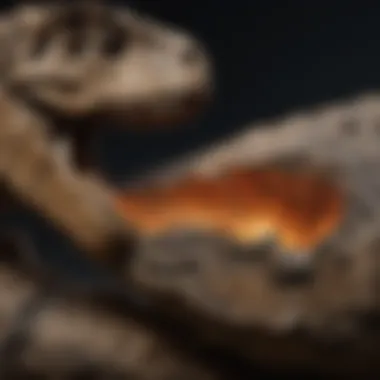Unraveling the Enigmatic World of Fossils: A Comprehensive Guide for Enthusiastic Collectors


Rock and Fossil Identification
In the vast realm of rock and fossil collecting, identification is a crucial first step. Understanding the various types of rocks and fossils is essential for enthusiasts to distinguish between sedimentary, igneous, and metamorphic rocks. Fossils come in diverse forms, ranging from skeletal remains to imprints and petrified wood. To identify them accurately, collectors should pay attention to key characteristics such as color, texture, and structure. Utilizing tools like magnifying glasses and geological hammers can aid in the meticulous examination required for precise identification.
Collecting Tips and Techniques
Embarking on a collecting expedition requires careful consideration of best practices to ensure a successful outing. Seasoned collectors recommend researching prime collecting sites known for their abundant fossil deposits. Implementing techniques for safe specimen extraction is crucial to preserve the integrity of the fossils. This involves tools such as chisels and brushes, allowing collectors to delicately remove specimens from their rocky matrices without causing damage.
Preservation and Display
Once treasures have been unearthed, the focus shifts to preservation and display. Preserving rocks and fossils involves utilizing techniques like fossil blocking, wrapping in archival paper, or stabilizing with consolidants to prevent deterioration. Proper storage methods, such as a cool, dry environment free from light exposure, are paramount in maintaining the condition of these geological wonders. Displaying fossils creatively, whether through shadow boxes, floating frames, or custom stands, adds a touch of artistry to showcasing these ancient marvels.
Geological Insights
Delving into geological insights offers a profound understanding of the world beneath our feet. Exploring geological formations and processes uncovers the intricate ways in which rocks and fossils come to exist in their current state. The historical significance of rocks and fossils lies in their ability to provide tangible clues to Earth's past, aiding scientists in reconstructing the planet's evolutionary journey. Noteworthy discoveries, such as rare fossil finds or groundbreaking geological research, showcase the ongoing exploration and wonder that define the field of geology and fossil collecting.
Introduction to Fossils
Definition and Significance
Understanding the concept of fossils
The concept of fossils encapsulates the preservation of long-extinct organisms or their imprints in rocks, providing a tangible link to life forms that once graced our planet. This key element of 'Understanding the concept of fossils' is instrumental in discerning the evolution of life on Earth and aids in reconstructing ecosystems from bygone eras. By grasping the nuances of fossilization, collectors can decode ancient biological processes and comprehend the intricate tapestry of life's evolution.
Significance of fossils in scientific research
Fossils stand as pillars of evidence in scientific endeavors, enabling researchers to piece together the intricate puzzle of geological history. The 'Significance of fossils in scientific research' extends far beyond mere curiosities, offering vital clues to Earth's climatic shifts, species interactions, and evolutionary trajectories. Their role in refining our understanding of paleoecology and biodiversity is profound, making fossils indispensable tools in unraveling the secrets of our planet's past.
Historical Perspective
The early discoveries of fossils
The early unearthing of fossils marked a pivotal moment in the annals of scientific discovery, unveiling a world shrouded in mystery and antiquity. 'The early discoveries of fossils' laid the groundwork for paleontological inquiry, propelling intrepid explorers and researchers into uncharted territories of Earth's ancient past. These initial findings sparked a fascination with the remnants of prehistoric life, fueling the pursuit of knowledge and understanding in the nascent field of paleontology.
Contributions of key figures in paleontology
Throughout history, visionary figures in paleontology have left an indelible imprint on the study of fossils, shaping our modern comprehension of ancient life forms. 'Contributions of key figures in paleontology' highlights the pioneering efforts of individuals who revolutionized the field, from groundbreaking discoveries to paradigm-shifting theories. Their invaluable contributions have not only enriched our knowledge of Earth's history but also inspired future generations to delve deeper into the enigmatic world of fossils.
Formation of Fossils
Process of fossilization
The process of fossilization comprises a myriad of intricate steps that culminate in the preservation of organisms for millions of years. Understanding the 'Process of fossilization' unravels the chemical and geological processes that transform once-living beings into enduring relics of the past. From mineralization to permineralization, this mechanism of preservation encapsulates the delicate dance between time and taphonomy, shaping the fossil record that captivates and astounds collectors and researchers alike.
Factors influencing fossil formation
Various factors govern the formation of fossils, dictating the conditions under which organic remains endure the test of time. Exploring the 'Factors influencing fossil formation' exposes collectors to the vagaries of sedimentation, decomposition, and diagenesis that ultimately shape fossil assemblages. Climate, geology, and biological processes interplay in a delicate balance, determining the fate of organisms as they transition from vibrant life to enduring fossils that inform and inspire generations to come.


Types of Fossils
In the realm of paleontology, understanding the various types of fossils is paramount for rock and fossil collectors. Types of Fossils play a crucial role in providing invaluable insights into Earth's history and the evolution of life on our planet. By delving into the differences between body fossils, trace fossils, and chemical fossils, collectors can uncover a wealth of information about ancient organisms and ecosystems. The significance of Types of Fossils cannot be understated, as they serve as windows into the past, offering tangible connections to bygone eras.
Body Fossils
Definition and examples
Body fossils represent the preserved remains of organisms, ranging from shells and bones to entire organisms such as dinosaurs. These fossils provide direct evidence of past life forms, offering a tangible link to ancient ecosystems and evolutionary processes. The key characteristic of body fossils lies in their ability to showcase the physical structures of ancient organisms, allowing researchers and collectors to study morphology, behavior, and adaptations. Their presence in this article enhances the comprehension of fossilization processes, highlighting the intricate details of past life forms.
Importance of body fossils
The importance of body fossils stems from their ability to provide detailed insights into the appearance and biology of extinct species. By studying body fossils, researchers can reconstruct the anatomical features of ancient organisms, decipher their evolutionary relationships, and unearth clues about past environments. This article underscores the significance of body fossils in elucidating the diversity of prehistoric life and understanding the mechanisms of evolution. Their inclusion enriches the discourse on fossil collection and preservation, emphasizing their irreplaceable value in scientific investigations.
Trace Fossils
Explanation and significance
Trace fossils consist of indirect evidence of past life activities, such as footprints, burrows, and feeding traces. Unlike body fossils, trace fossils provide information about behavior, locomotion, and ecological interactions of ancient organisms. The key characteristic of trace fossils lies in their ability to reveal the behavioral patterns of extinct organisms, offering unique insights into their lifestyles and ecological roles. Their presence in this article enhances the understanding of ancient ecosystems and the interconnectedness of species within them.
Common types of trace fossils
Common types of trace fossils include tracks, trails, and borings, which offer clues about the movements and behaviors of organisms in the past. These traces provide valuable information about ancient habitats, predator-prey relationships, and environmental conditions. By exploring common types of trace fossils, collectors gain a deeper appreciation for the variety of life forms that existed in prehistoric times. Their discussion in this article broadens the scope of fossil studies, encouraging a holistic approach to understanding Earth's biological history.
Chemical Fossils
Overview and role in paleontology
Chemical fossils are organic compounds preserved in rocks that provide information about ancient organisms and ecosystems. These fossils offer insights into the biochemical composition of past life forms, including their diets, metabolic processes, and environmental interactions. The key characteristic of chemical fossils lies in their ability to complement body and trace fossils by elucidating the molecular signatures of ancient organisms. Their incorporation in this article expands the exploration of fossilization mechanisms, emphasizing the intricate chemical processes involved in preserving biological remnants.
Applications of chemical fossils
The applications of chemical fossils extend to a wide range of scientific disciplines, including paleoclimatology, paleoecology, and evolutionary biology. By analyzing chemical fossils, researchers can reconstruct ancient environments, track changes in biodiversity, and unravel evolutionary patterns over geological time scales. This article highlights the relevance of chemical fossils in expanding the interdisciplinary nature of paleontological research, fostering collaborations between geologists, biologists, and chemists. Their integration enriches the narrative on fossil diversity and the advancement of analytical techniques in paleontology.
Importance of Fossils
Fossils play a pivotal role in understanding Earth's history, serving as a window into the past for rock and fossil collectors. In this comprehensive guide, the Importance of Fossils is underscored through their ability to provide invaluable insights into past life forms, ecosystems, and geological processes. By studying fossils, collectors can gain a profound appreciation of how life has evolved over millions of years, aiding in unlocking mysteries of biodiversity and environmental changes. Emphasizing the need for responsible fossil collection practices, this section delves into the ethical considerations and legal aspects involved in preserving these priceless remnants of Earth's ancient inhabitants.
Paleontological Studies
Insights into evolutionary history:
Fossils offer a unique glimpse into the evolutionary history of life on Earth, allowing researchers and collectors to trace the development of species over time. Through the study of fossilized remains, valuable information on ancestral lineages, evolutionary transitions, and adaptation strategies can be gleaned, contributing significantly to understanding the mechanisms that have shaped the vast diversity of life forms on our planet. Highlighting key features such as transitional forms, phylogenetic relationships, and morphological changes, Insights into evolutionary history stand out as a cornerstone in paleontological studies within this guide, facilitating a deeper appreciation of the interconnectedness of all living organisms.
Environmental indicators from fossils:
Fossils serve as crucial environmental indicators, offering vital clues about past climates, ecological conditions, and biodiversity patterns. By analyzing the distribution and composition of fossil assemblages, researchers can reconstruct ancient environments, track changes in species distributions, and infer past climatic variations. This section sheds light on the significance of Environmental indicators from fossils in deciphering Earth's environmental history, illustrating how fossil data can enhance our grasp of ecosystems dynamics, habitat changes, and the impacts of environmental shifts on fauna and flora. While providing valuable insights, it is imperative to recognize the limitations and biases inherent in interpreting fossil evidence, encouraging a nuanced approach to understanding the complexities of ancient ecosystems.
Geological Significance


Dating geological formations:
Dating geological formations through fossils is a cornerstone of stratigraphic analysis, enabling geologists and paleontologists to establish the relative ages of rock layers and determine the chronology of Earth's geological events. By correlating fossil assemblages with established stratigraphic principles, researchers can construct accurate geological timelines, unraveling the sequences of sedimentary deposition, tectonic movements, and other geological processes. This section highlights the indispensable role of Dating geological formations in reconstructing Earth's geological history, showcasing how fossils provide key markers for dating rocks and understanding the temporal evolution of landscapes.
Understanding past climate changes:
Fossils serve as invaluable proxies for reconstructing past climate conditions, offering critical evidence for elucidating major climatic shifts throughout Earth's history. By studying fossilized flora, fauna, and isotopic compositions, scientists can infer past temperature regimes, precipitation patterns, and environmental adaptations of ancient organisms. This segment delves into the significance of Understanding past climate changes through fossils, illuminating how paleoclimatological data derived from fossils can enhance our comprehension of past climatic oscillations, ice age dynamics, and long-term environmental trends. While providing indispensable information, it is essential to acknowledge the uncertainties and complexities involved in interpreting fossil data, advocating for multidisciplinary approaches to unraveling the intricacies of Earth's past climates.
Collecting and Preserving Fossils
In this section of the article, we delve into the vital topic of Collecting and Preserving Fossils, shedding light on the significance it holds within the realm of fossils and rock collections. For rock and fossil collectors, understanding the art of preserving fossils is paramount to maintaining the integrity and scientific value of their findings. By embracing proper collecting techniques and preservation methods, collectors can ensure the longevity of the specimens and contribute to the preservation of valuable scientific data.
Ethical Considerations
Responsible collecting practices
Responsible collecting practices play a crucial role in the ethical acquisition of fossils, emphasizing the importance of sustainable and respectful collecting methods. By adhering to responsible practices, collectors help safeguard fossil sites, minimize ecological impact, and promote scientific collaboration. The key characteristic of responsible collecting practices lies in prioritizing conservation efforts and fostering a culture of responsible stewardship within the collecting community. This approach not only benefits the environment but also enhances the credibility and credibility of collectors within the scientific community.
Legislation regarding fossil collection
Legislation regarding fossil collection acts as a regulatory framework guiding the ethical and legal aspects of collecting fossils. By setting clear guidelines and restrictions, legislation aims to prevent illicit trade, protect culturally significant specimens, and ensure sustainable collection practices. The key characteristic of legislation regarding fossil collection is its role in maintaining the balance between scientific exploration and conservation efforts. While legislation offers necessary protection for fossil resources, it may also pose challenges related to regulatory compliance and bureaucratic hurdles.
Preservation Techniques
Methods for fossil preservation
Effective methods for fossil preservation are essential for maintaining the integrity and scientific value of collected specimens. By employing techniques such as casting, molding, or stabilizing fragile fossils, collectors can ensure the long-term conservation of their discoveries. The key characteristic of methods for fossil preservation lies in their ability to prevent deterioration and enhance the longevity of fossils for future study and exhibition.
Long-term care and storage
Proper long-term care and storage are crucial aspects of preserving fossils for extended periods. By creating suitable storage conditions, such as controlled humidity and temperature levels, collectors can prevent degradation and damage to their specimens over time. The key characteristic of long-term care and storage is the commitment to ensuring the continued preservation of fossils for ongoing research and educational purposes. While effective storage practices promote longevity, inadequate care can lead to irreparable harm to valuable fossil collections.
Fossil Identification
In the realm of fossils, the process of identification plays a crucial role in unraveling the mysteries of the past. Fossil identification is not merely about recognizing specimens; it is a gateway to understanding the ancient organisms that once roamed the Earth and the environments they inhabited. This section delves into the significance of fossil identification within the broader context of paleontological studies, highlighting its essential role as a tool for interpreting evolutionary history and environmental changes.
Key Identification Features
Characteristics for Fossil Recognition
When it comes to identifying fossils, certain key characteristics serve as the linchpin for accurate classification and interpretation. Characteristics for fossil recognition encompass a variety of factors, including morphology, texture, coloration, and structural details unique to each specimen. By honing in on these distinct features, collectors and researchers can infer crucial information about the organism's taxonomy, lifestyle, and evolutionary relationships. This detailed analysis not only aids in cataloging fossil diversity but also provides valuable insights into past ecosystems and biological adaptations, making it a foundational aspect of paleontological research.
Tools for Fossil Identification
Complementing the observational skills required for fossil identification, the utilization of specialized tools enhances accuracy and efficiency in the classification process. Tools such as magnifying lenses, geological hammers, and digital imaging equipment enable collectors to conduct detailed examinations of fossils, revealing intricate details that may not be visible to the naked eye. These tools not only facilitate precise identifications but also contribute to the preservation and documentation of fossil specimens for future study. By incorporating modern technologies into the identification process, enthusiasts can enhance their understanding of ancient life forms and contribute valuable data to the scientific community.
Common Fossil Misidentifications


Despite meticulous observation and the aid of tools, the identification of fossils is not without its challenges. Common pitfalls in fossil identification include misinterpretations of geological context, incomplete specimen preservation, and convergent evolution leading to resemblances between unrelated organisms. These factors can sometimes result in misidentifications that may skew our understanding of evolutionary patterns and ecological interactions. By being mindful of these potential pitfalls and cross-referencing findings with established scientific literature, collectors can mitigate errors and ensure more accurate identifications.
Tips to Avoid Misidentifying Fossils
To navigate the landscape of fossil identification successfully, adhering to certain tips can significantly enhance the accuracy of classifications. Strategies such as consulting with experts, attending workshops or field trips, maintaining detailed records of findings, and continuously expanding taxonomic knowledge base can minimize the risk of misidentifications. By exercising caution, conducting thorough research, and seeking peer review when in doubt, collectors can cultivate a more nuanced understanding of fossils and contribute meaningfully to the field of paleontology.
Fossil Display and Exhibition
In the realm of rock and fossil collection, Fossil Display and Exhibition plays a pivotal role in sharing the wonders of paleontology with enthusiasts and the general public alike. It serves as an educational and captivating medium through which the beauty and significance of fossils are showcased, fostering a deeper appreciation for the Earth's ancient history and the processes that have shaped it. By providing a platform for showcasing fossils in a visually appealing and informative manner, Fossil Display and Exhibition not only educates but also inspires curiosity and awe.
Creating a Fossil Exhibit
Designing an engaging fossil display
Designing an engaging fossil display is a crucial aspect of Fossil Display and Exhibition, as it sets the stage for captivating the audience and delivering a memorable experience. The key characteristic of designing such displays lies in striking a balance between visual appeal and educational content, ensuring that the narrative behind each fossil is effectively communicated. By incorporating interactive elements, engaging visuals, and informative signage, designing an engaging fossil display enhances the overall impact of the exhibition, making it both educational and visually stimulating.
Tips for showcasing fossils effectively
Showcasing fossils effectively involves careful planning and execution to maximize the impact of the exhibition. One of the key characteristics of effective showcasing is creating thematic displays that tell a coherent story or convey a specific scientific concept. This approach not only makes the exhibition more engaging for visitors but also facilitates learning and understanding. Additionally, utilizing proper lighting, clear labeling, and interactive elements can further enhance the effectiveness of showcasing fossils, ensuring that the audience is fully immersed in the exhibition's narrative.
Public Outreach and Education
Public Outreach and Education are essential components of Fossil Display and Exhibition, as they enable broader access to paleontological knowledge and foster a sense of community engagement. By reaching out to schools, museums, and other public venues, exhibitions can attract diverse audiences and spark interest in paleontology. Engaging the community through exhibits allows for the dissemination of scientific knowledge in a relatable and accessible manner, promoting greater awareness and appreciation for fossils and their significance.
Engaging the community through exhibits
Engaging the community through exhibits involves creating interactive and informative displays that cater to a wide range of audiences. The key characteristic of such outreach is the ability to connect with visitors on a personal level, making complex scientific concepts understandable and engaging. By incorporating hands-on activities, guided tours, and educational workshops, exhibits can appeal to both novice enthusiasts and seasoned experts, making learning about fossils a truly immersive experience.
Educational resources for fossil enthusiasts
Providing educational resources for fossil enthusiasts is integral to the success of Fossil Display and Exhibition, as it empowers visitors with the knowledge and tools to further explore the world of paleontology. The key characteristic of these resources is their accessibility and relevance, offering information that is both informative and engaging. By distributing brochures, pamphlets, and digital content, exhibitions can extend their educational impact beyond the physical space, reaching a wider audience and inspiring continued learning and discovery.
Future Prospects in Paleontology
Paleontology is a dynamic field constantly evolving through technological advancements, offering unprecedented insights into Earth's history and biological evolution. Understanding the future prospects in paleontology is crucial as it shapes the direction of research and discoveries in the coming years. This section delves into the specific elements, benefits, and considerations of future prospects in paleontology within the context of rock and fossil collectors' interests.
Technological Advancements
Impact of Technology on Fossil Studies
Technology has revolutionized the field of paleontology by enhancing the way fossils are studied and interpreted. From high-resolution imaging techniques to advanced laboratory equipment, technology has significantly accelerated the process of fossil analysis. The key characteristic of technology's impact on fossil studies lies in its ability to uncover intricate details of fossils that were previously inaccessible. This aspect is a valuable choice for this article as it emphasizes the importance of technological breakthroughs in enhancing our understanding of fossils. One unique feature of technology in fossil studies is the implementation of 3D imaging, allowing researchers to visualize fossils in unprecedented detail. While technology offers numerous advantages such as precise reconstructions and data analysis, it also comes with challenges like the need for specialized skills and maintenance costs.
Virtual Reality in Paleontological Research
Virtual reality (VR) has emerged as a revolutionary tool in paleontological research, providing immersive experiences for researchers and enthusiasts alike. VR allows users to explore ancient environments, interact with virtual fossils, and participate in virtual excavation simulations. The key characteristic of VR in paleontological research is its ability to bridge the gap between scientific study and public engagement by offering interactive experiences. This makes VR a popular choice for this article as it highlights the potential of virtual reality in making paleontology more accessible and engaging. A unique feature of VR is its potential for creating virtual museums and educational platforms, allowing users to virtually examine rare specimens. While VR offers advantages in education and outreach, it also has challenges such as equipment costs and technological limitations.
Emerging Fields
Biostratigraphy and Its Applications
Biostratigraphy plays a fundamental role in paleontological studies by utilizing fossil data to establish the relative ages of rock formations. This method helps in correlating strata and understanding the chronological order of Earth's history. The key characteristic of biostratigraphy lies in its ability to stratigraphically zone rocks based on fossil content, making it a beneficial choice for this article as it emphasizes the importance of stratigraphic correlation in paleontology. One unique feature of biostratigraphy is its use of index fossils to define biozones, providing a basis for geological dating. While biostratigraphy offers advantages in correlating geologic sequences and identifying depositional environments, it may face challenges regarding fossil availability and regional variations.
Paleogenomics and Evolutionary Insights
Paleogenomics explores the genetic material preserved in ancient organisms, offering unprecedented insights into evolutionary processes and genetic relationships. By studying ancient DNA, researchers can reconstruct phylogenetic trees and unravel evolutionary patterns across species. The key characteristic of paleogenomics is its ability to investigate genetic changes over time, providing a deeper understanding of evolutionary trajectories. This aspect makes paleogenomics a popular choice for this article as it highlights the integrative approach of genomics in paleontological research. A unique feature of paleogenomics is its potential to resolve phylogenetic controversies and refine evolutionary timelines, although challenges such as DNA degradation and contamination need to be addressed.







